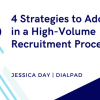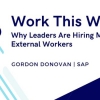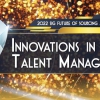Outsource: Joe, thank you very much for joining Outsource today. We always begin interviews by asking for a little bit of an introduction to yourself and your organisation for our readers – so, over to you…
Joe Musacchio: I am the CEO of PeopleTicker. PeopleTicker is a rate and benchmarking tool, we cover salary and contingent labour benchmarking. We basically help companies that want to know how much somebody costs, for projects, individuals, recruitment, sourcing, and procurement.
O: Is your typical client US-based? Or are you totally global?
JM: We are global, we’re presently in eleven countries and we will be in 100 probably about twelve months from now.
O: That’s pretty great ambition!
JM: Well the company has been around since 2001; it was proprietary software
for a VMS, and we spun it off when we sold the VMS because we saw a market need for this type of information.
O: And what’s the relationship with John Sculley?
JM: John is our chairman; he was a friend of the firm to begin with and he took a liking to it, and as John does when he likes things, he gets involved.
O: Can you tell us a little about the kind of engagement that you would typically have with a client? How do you go about starting a relationship? Who is your buyer inside the target?
JM: Basically companies are trying to manage the largest spend they have, which is contingent labour and what we do with companies is, build market rate cards for them. We develop all their jobs, all the job descriptions; and do project management around that to deliver a rate card that they are able to buy from. If they know the market pay rates and statutory costs, they are in a better position to negotiate with their suppliers, find the right talent quickly, and retain them.
O: Who within the organisation do you tend to speak with? Is it procurement? Is it HR?
JM: We actually speak to both HR and procurement. In the organisation HR is usually responsible for hiring people and procurement for buying them. As the contingent labour market explodes – I think we’re going to be up to 40% by 2020 – HR is now starting to evolve into the management of contingent in partnership with procurement. So rather than just buying, procurement is now also responsible for negotiations and HR is now getting involved in the human aspect of the human resources they’re bringing in.
O: One of the things that John was talking about is the changing nature of work, and this is a huge issue for everyone – procurement, HR, the general population: as automation kicks in, the role of work is changing. So how are you positioning your company to adapt to that and take advantage of what’s happening?
JM: Let’s talk about the change in the workforce. I think a lot of it stems from free agency. People decide that they don’t want to get involved in the internal politics of the company, they don’t want to get involved in trying to move up in a company, stay somewhere 30 years: they want to move quickly, and they want it now. Even before this generation, people always wanted things quickly, and I believe that folks want to do it on their own. They want to get into their own corporations, into their own companies. That’s coupled with less employer loyalty and with regulation: you know some of the healthcare bills that have gone through recently, the burden is on the employer to provide more benefits. The government makes laws and business works its way around them.
So this is a piece of that, and I also think it’s an opportunity for folks to get moving on their own. Technology has enabled this type of environment, where people don’t have to be at work. I believe that companies are starting to look at keeping core staff that is focused around the business, and creating an ecosystem around it that delivers projects. That’s how PeopleTicker runs its business. We’ve got nine folks that are core, and 430 in our ecosystem that are actually employed by the company.
Let’s just take a look at this in IT for a second. Let’s take a development program, and let’s say a developer is going to cost us $120,000: what can that developer do in 12 months through management of them? Trying to get different projects out and getting results. If we broke that into $10,000 for each of 12 projects, and the person only got paid when they delivered a result, and all we had to do was integrate that software into the package, we find that we’re getting a lot more results this way. We’ve got folks in Moscow, in California, Poland, folks in the Ukraine, all over the place. It’s an interesting model and it’s working both on the sales side and the HR side too, where we have compensation people all over the world doing validation. We have procurement people doing validation for us, we have recruiters that are bringing different types of jobs to the table, and we’re up to 84,000 different job titles – so it’s happening. We call it SkillsVillage, a crowdsourced community for compensation validation.
O: It’s interesting because when you started talking about the change in the nature of work you were placing it very squarely on the shoulders of the employee and changing attitudes to work and wanting to move a lot, and lack of loyalty, and then the second stage of that is the responsibility being on the employer and working around legislation…
JM: I think the government starts it with legislation; the employer reacts to it, as a capitalist; and then the person reacts to that. There’s always a counter balance.
O: So where’s next for you guys then? You’ve outlined pretty ambitious growth over the next 12 months country-wise; what else are you looking to achieve over the course of, say, the next business cycle?
JM: Well we see ourselves providing a critical function in the industry. We have started to get involved in full service consulting roles, and vendor selection. Monitoring pay rates, bill rates, training managers, training project managers. There’s a consulting piece of it that seems to be pulling us in, we’ve just got to have a consulting business. But you kind of get pulled back in, as Al Pacino says. I think the company’s just going to stay focused on how much we see on the HR side, the salary side is booming and it’s an accepted practice there compensation-wise, and I think the contingent piece is just coming into its own where procurement is starting to learn that there is a service sitting here to help them. Folks need to know how much they’re paying today.
The whole thing is very exciting: the whole model and what’s happening to the industry, what’s happening to the government, what’s happening to the employer. The world is really morphing and we’re pretty honoured to be a part of it.
O: At Outsource we see a lot of this being driven by globalisation and the fact that people can source work from different geographies; I’m wondering how much you feel that drives things.
JM: Well I think it might be an evolution of the term “outsourcing”. I always believed that after all the outsourcing was going to happen, everyone was going to be insourcing, and this is sort of an insourcing: very closely held projects versus taking the whole IT/HR department.
O: Maybe that was a learning process for the organisation generally realising over the course of several years that actually it’s not necessary to have all of this structured in that traditional way, that it’s not the most efficient way of doing things?
JM: I think it’s smart to move in this way – and I’m sure with machine learning and other things that are coming, we’ll be buying McDonald’s from machines soon.





